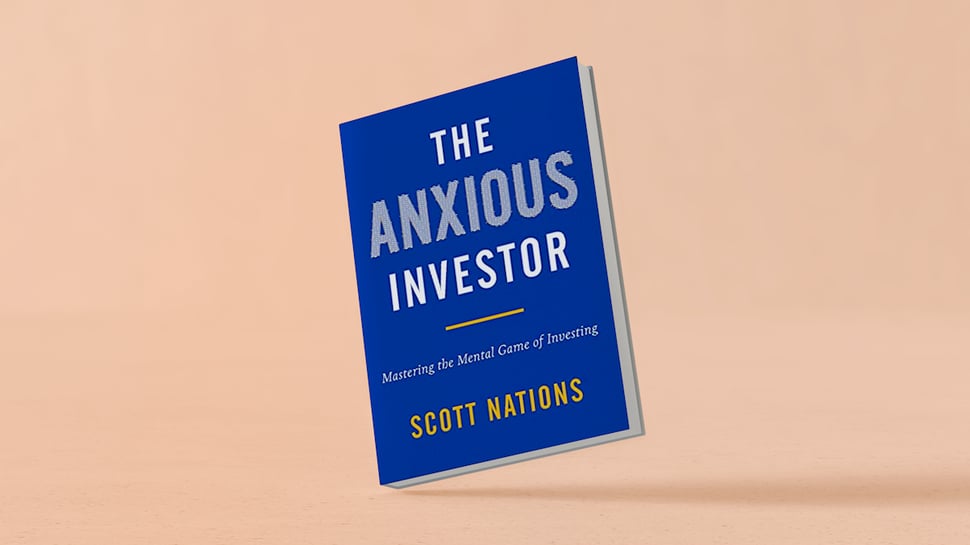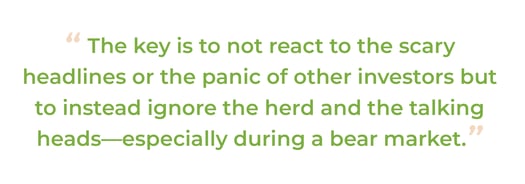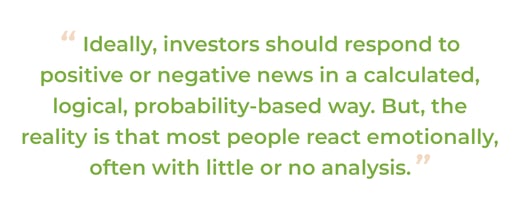At Evolutionary Tree Capital Management, we get inspiration from a variety of sources. Books are some of the best sources, especially for long-term investors, as they often touch on timeless topics, help inform one’s investment approach, and provide perspective for investors.
In our new blog series, Books That Inspire Us, we’ll be sharing our favorite book titles with you, along with why we like them, what we learned from them, and how they inspire the work that we do here at Evolutionary Tree.
We’re excited to kick off this series with a book review by Tom Ricketts, our firm’s chief investment officer. He chose a book that seems appropriate for navigating through turbulent times.
 Q&A with Tom Ricketts, CFA on The Anxious Investor: Mastering the Mental Game of Investing (By Scott Nations)
Q&A with Tom Ricketts, CFA on The Anxious Investor: Mastering the Mental Game of Investing (By Scott Nations)
Tom: Riding through bear markets is one of the toughest jobs for investors, yet it is essential for long-term wealth creation. In my opinion, no one can consistently time the market or the economy. The key is to not react to the scary headlines or the panic of other investors but to instead ignore the herd and the talking heads—especially during a bear market. With equity markets continuing to take investors on a roller coaster ride, I can’t think of a better book recommendation than The Anxious Investor: Mastering the Mental Game of Investing. In this fantastic new book, author Scott Nations, explains how emotions and behavioral biases can keep investors from achieving their investment goals. He also offers strategies for how to stay the course when markets get turbulent.
With equity markets continuing to take investors on a roller coaster ride, I can’t think of a better book recommendation than The Anxious Investor: Mastering the Mental Game of Investing. In this fantastic new book, author Scott Nations, explains how emotions and behavioral biases can keep investors from achieving their investment goals. He also offers strategies for how to stay the course when markets get turbulent.
To start, I found the following excerpt from The Anxious Investor particularly timely:
Investors overreact during crashes and bear markets…Most of us overreact to unexpected and dramatic events. It may be an evolutionary remnant of a time when an extreme reaction to a physical threat had little or no cost. That is no longer the case: an investor who overreacts and sells at the bottom experiences a real cost, the opportunity cost of not being invested when the market inevitably rallies.
The concept of behavioral biases is not new to the professional investors at Evolutionary Tree. However, we find it exceptionally relevant given recent market volatility and shared this in our first quarter letter to clients.
With the pullback in stock prices and valuations relative to continued growth for portfolio companies, there is now a big disconnect that we believe could lead to a significant rebound in the future. The timing of this rebound is unknown…but we believe patience will be rewarded…history also shows that bear markets typically end, often in fewer than 12 months, and the post-bear rebound can be more significant and long-lasting. Investors whose time horizons are measured in years should remind themselves that this longer-term mindset arms them with the ability to ride through storms and benefit from that eventual rebound. While this is the logic behind successful long-term investing, we also want to acknowledge the emotional component and the need to have both courage and patience.
Why is The Anxious Investor a valuable read for investors?
Tom: We’re currently in a significant bear market caused by record-high inflation and rapidly rising interest rates. The war in Ukraine has exacerbated the situation. While difficult, the only way for long-term investors such as ourselves to achieve our investment goals is to ride out these bear markets. Doing that requires managing our emotions and keeping our biases in check.
Author Scott Nations describes several emotions that can undermine successful investing. Which ones do investors struggle with most frequently?
Tom: The “herding bias” is one of the most common among investors. This is the concept that humans will imitate other humans for some perceived informational value, rather than making studied and independent decisions based on deep analysis. The problem with herding is that it can lead to bubbles on the upside and crashes on the downside. So if a stock price is rising, others may pile into the stock—often without any type of fundamental analysis—and drive the stock even higher, and vice versa on the downside. Sometimes this dynamic can become even more broad-based across the markets.
Consider GameStop, a brick-and-mortar store that sells packaged video games. This is a low-quality business, in our assessment, that is losing its relevance as games move to cloud-connected consoles and mobile phones. And yet, in 2021, GameStop’s stock skyrocketed amid a meme stock trading frenzy. As an investor whose stock selections are based strictly on business fundamentals, I thought it was silly that investors would buy shares of a company that has such an outdated business model. In our evolutionary lens framework, we would classify GameStop as a legacy older-generation business being displaced by cloud and mobile-based apps. Despite this fact, the hype around GameStop led to a herding bias as meme investors mimicked each other. While this is an extreme example of herding, we see this dynamic fairly frequently.
Another behavior that prevents people from achieving their investment goals is the “overreaction bias.” Ideally, investors should respond to positive or negative news in a calculated, logical, probability-based way. But, the reality is that most people react emotionally, often with little or no analysis. For example, in March of 2022, when it became clear that Russia had launched a full-scale invasion of Ukraine, fears of a nuclear war emerged, triggering 3%–5% daily declines in the market. While the war in Ukraine is devastating, the dramatic downturn in the market at that time was driven primarily by investors overreacting to scary headlines.
For example, in March of 2022, when it became clear that Russia had launched a full-scale invasion of Ukraine, fears of a nuclear war emerged, triggering 3%–5% daily declines in the market. While the war in Ukraine is devastating, the dramatic downturn in the market at that time was driven primarily by investors overreacting to scary headlines.
At Evolutionary Tree, we believed the probability of a nuclear war or other larger-scale catastrophe was much lower than what was expressed in the market, so we managed our reactions to these dramatic events and focused on making investment decisions based purely on the fundamentals of each business. Meanwhile, the overreactions exacerbated the bear market and created buying opportunities. We took advantage of those opportunities and purchased the stocks of several high-quality innovators at incredibly attractive valuations.
Importantly, overreaction also can be triggered by something as prosaic as a company announcement, such as a short-term setback with a product. Investors tend to react first and analyze second. Then, through the fullness of time and analysis, they come to find the situation may not be quite as bad. This is where focusing on the long-term fundamentals—such as innovation, secular trends, and competitive advantage—arms the long-term investor to weigh new information thoughtfully versus reacting.
How does Evolutionary Tree avoid making investment decisions based on emotional biases?
Tom: We invest only in companies in which we have long-term conviction and confidence. We gain this confidence through a stock-by-stock selection process based on a disciplined set of investment criteria. By focusing on innovative companies that have differentiated business models, products, or services, sustainable growth, and strong balance sheets, we’re able to confidently stand by our holdings while the broader markets are selling off.
That said, we don't ignore the negative events happening in the world. An important part of our process includes assessing whether these events create risks for the companies we own. Most recently, these assessments have made us more confident that highly innovative companies can get through these inflationary and recessionary times. Why? Because they typically have pricing power and competitive advantages. It’s as though, through innovation, these companies have been able to create their own weather by creating differentiated new products and services that sustain growth. In fact, during the most recent earnings season, many of the leading innovators we own reported top-line growth of 25%–35% or more—despite the economic slowdown.

